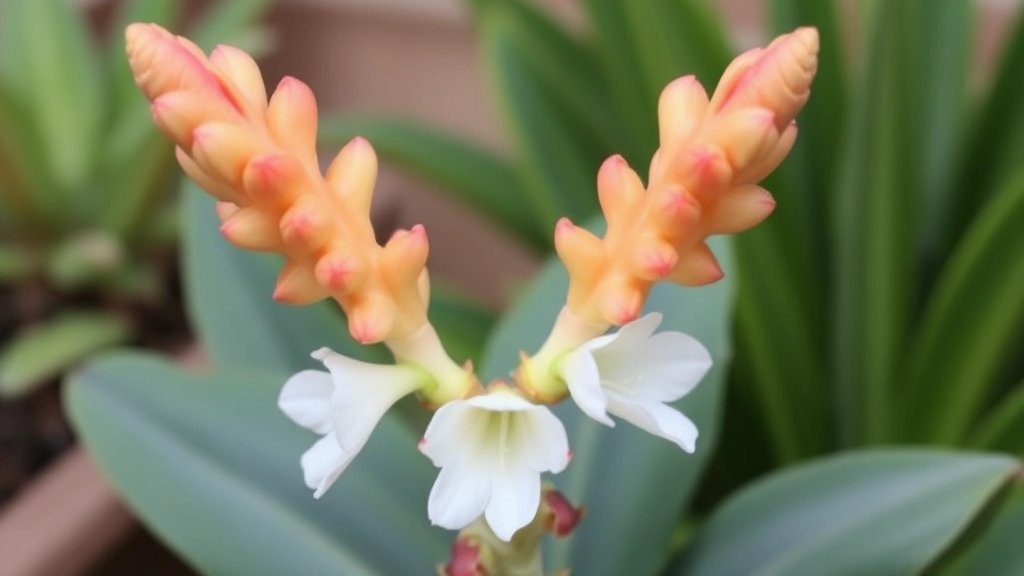Growing Kalanchoe Gastonis-Bonnieri
When it comes to growing Kalanchoe Gastonis-Bonnieri, also known as Donkey Ears, understanding its growth requirements is key. This unique succulent thrives in bright, indirect light and prefers well-draining soil. Keeping the temperature between 15-25°C ensures optimal growth, making it a versatile plant for both indoor and outdoor settings.
Watering and Care
Watering your Donkey Ears plant correctly is crucial; overwatering can lead to root rot. Allow the soil to dry out between waterings and apply a balanced fertilizer during the growing season for best results. With the right care, your Kalanchoe Gastonis-Bonnieri will flourish, showcasing its distinctive, large leaves and vibrant blooms.
Growth Requirements for Kalanchoe Gastonis-Bonnieri
Are you struggling to keep your Kalanchoe Gastonis-Bonnieri thriving? Understanding its growth requirements is essential for a healthy plant.
Light Conditions
Kalanchoe Gastonis-Bonnieri flourishes in bright, indirect sunlight.
- Optimal Light: Aim for 6 hours of light daily.
- Avoid Direct Sun: Too much direct sunlight can scorch the leaves. For more details, check out our Optimal Light for Kalanchoe guide.
Soil Type
The right soil mix is crucial for growth.
- Well-Draining Soil: A cactus or succulent potting mix works best.
- pH Level: Ideally, the soil should be slightly acidic to neutral (pH 6.0 to 7.0). Learn more in our Complete Guide to Kalanchoe Plant Care.
Temperature and Humidity
Kalanchoe Gastonis-Bonnieri prefers a stable environment.
- Temperature Range: Keep it between 20°C to 25°C (68°F to 77°F).
- Humidity: This plant thrives in low to moderate humidity levels.
Potting and Repotting
Choosing the right pot and timing for repotting can impact growth.
- Pot Size: Use a pot that’s slightly larger than the root ball.
- Repotting Frequency: Every 2-3 years, or when roots outgrow the pot.
Watering and Fertilization Tips for Kalanchoe Gastonis-Bonnieri
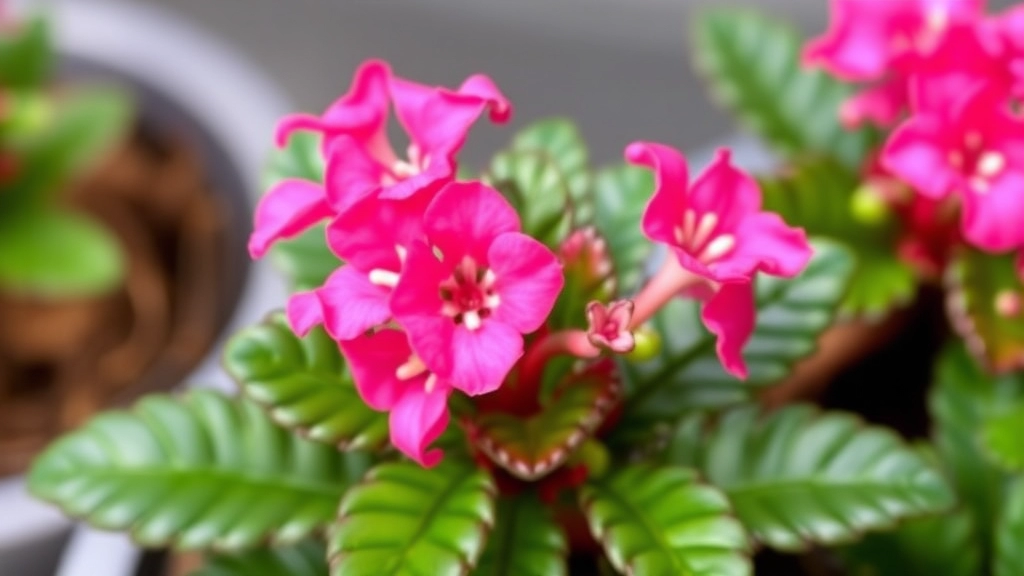
So, you’ve got your Kalanchoe Gastonis-Bonnieri, and now you’re wondering, “How much water does this plant really need?”
Well, let’s dive into it.
Watering
- Frequency: Water your Kalanchoe only when the top inch of soil feels dry. This could mean every 2-3 weeks, depending on your environment.
- Method: When you do water, give it a good soak. Ensure excess water drains out—standing water can lead to root rot.
- Signs of Overwatering: Yellowing leaves or mushy stems? Time to cut back on the watering.
- Signs of Underwatering: If the leaves start to shrivel, it’s begging for a drink!
Fertilization
- Type of Fertilizer: Use a balanced, water-soluble fertilizer. A 20-20-20 mix works wonders.
- Frequency: Feed your plant every 4-6 weeks during the growing season (spring and summer).
- Dilution: Always dilute your fertilizer to half the recommended strength to avoid burning the roots.
- Winter Care: Cut back on fertilization in the winter months when the plant is dormant.
Remember, less is more when it comes to both watering and fertilization.
Propagation Techniques
When it comes to propagating Kalanchoe Gastonis-Bonnieri, many plant enthusiasts often wonder about the best methods to ensure success. Propagation can be a rewarding experience, allowing you to expand your collection or share the joy of this unique plant with friends.
1. Leaf Cuttings
- Select Healthy Leaves: Choose mature, healthy leaves from the parent plant.
- Cut and Dry: Use a clean, sharp knife to cut the leaf. Allow it to dry for a few hours to form a callous.
- Planting: Place the leaf on top of well-draining soil. You can lightly press it down, but don’t bury it.
- Watering: Mist the leaf lightly until roots develop, usually within a few weeks.
2. Offsets
- Identify Offsets: Look for small plantlets or offsets at the base of the parent plant.
- Separation: Gently twist or cut the offset away from the main plant.
- Replant: Plant the offset in its own pot with fresh soil.
- Care: Water it lightly until established.
3. Stem Cuttings
- Choose a Stem: Select a healthy stem with several leaves.
- Cut: Use a sharp knife to cut a section of the stem, ideally about 4-6 inches long.
- Drying: Allow the cutting to dry for a day or two to form a callous.
- Planting: Insert the cutting into well-draining soil and water sparingly.
Propagating Kalanchoe Gastonis-Bonnieri can be a fulfilling process, allowing you to witness the growth of new plants from cuttings or offsets. For more detailed steps, you might find our guide on how to grow Kalanchoe from cuttings very helpful. Additionally, understanding the care guide for Kalanchoe Mother of Millions can provide further insights into successful propagation techniques.
Common Pests and Diseases
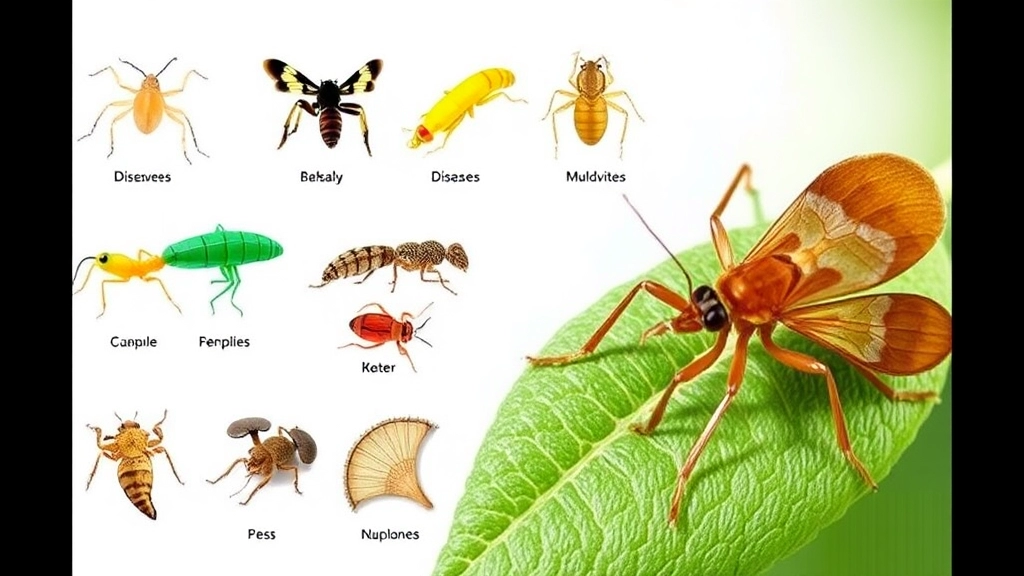
As we delve deeper into caring for Kalanchoe Gastonis-Bonnieri, it’s crucial to address the potential threats that can hinder its growth.
Identifying Common Pests
Kalanchoe plants can attract a variety of pests. Here are the most common ones to watch out for:
- Aphids: These tiny insects suck the sap from the leaves, causing wilting and distortion.
- Mealybugs: Recognisable by their white, cotton-like appearance, they can lead to leaf drop and stunted growth.
- Spider Mites: These pests thrive in dry conditions and leave fine webs on the plant. Look for speckled leaves as a sign of infestation.
- Scale Insects: These appear as small, brown bumps on stems and leaves, sucking the life out of your plant.
Diseases to Monitor
In addition to pests, Kalanchoe can be susceptible to certain diseases:
- Root Rot: Often caused by overwatering, this disease leads to mushy roots and can be fatal if not addressed quickly.
- Powdery Mildew: This fungal infection manifests as a white powdery substance on leaves, thriving in humid environments.
- Leaf Spot: Dark, water-soaked spots on leaves can indicate bacterial or fungal infections.
Prevention and Treatment
To keep your Kalanchoe healthy, consider these preventive measures:
- Regular Inspections: Check your plant weekly for any signs of pests or diseases.
- Proper Watering: Ensure you’re not overwatering, as this is a leading cause of root rot.
- Good Air Circulation: Keeping your plant in a well-ventilated area reduces humidity and helps prevent mildew.
- Neem Oil: This natural pesticide can effectively manage pest infestations without harming your plant.
If you do encounter pests or diseases, act quickly. Remove affected leaves, treat with appropriate solutions, and adjust care practices.
As we explore the various aspects of caring for Kalanchoe Gastonis-Bonnieri, it’s essential to touch on its medicinal properties. Many plant enthusiasts often wonder about the health benefits this succulent can offer.
Kalanchoe Gastonis-Bonnieri, commonly known as Mother of Thousands, possesses several medicinal properties that have been recognised in traditional medicine. Here are some notable benefits:
– **Wound Healing**: The leaves contain compounds that may promote faster healing of cuts and abrasions. Applying crushed leaves directly to minor wounds can provide relief and support recovery.
– **Anti-inflammatory Properties**: This plant is known for its ability to reduce inflammation. It can be used in poultices to alleviate swelling and pain associated with injuries or conditions like arthritis.
– **Respiratory Health**: Some cultures use Kalanchoe Gastonis-Bonnieri to support respiratory health. Inhaling the vapours from the plant can help alleviate symptoms of coughs and colds.
– **Digestive Aid**: The succulent is believed to have properties that support digestive health, potentially easing discomfort from indigestion.
– **Antimicrobial Effects**: Preliminary studies suggest that Kalanchoe may possess antimicrobial properties, making it beneficial for combating infections.
It’s important to note that while these uses are grounded in traditional practices, scientific research is still ongoing. Always consult with a healthcare professional before using any plant for medicinal purposes. For more information on how to grow and care for Kalanchoe Gastonis-Bonnieri, you might find our [comprehensive guide](https://planthq.org/comprehensive-guide-caring-for-kalanchoe-brasiliensis/) useful. Additionally, if you’re interested in other varieties and their care, check out our article on [top fuzzy Kalanchoe types for your garden](https://planthq.org/top-fuzzy-kalanchoe-types-for-your-garden/).
VI. Pruning and Maintenance
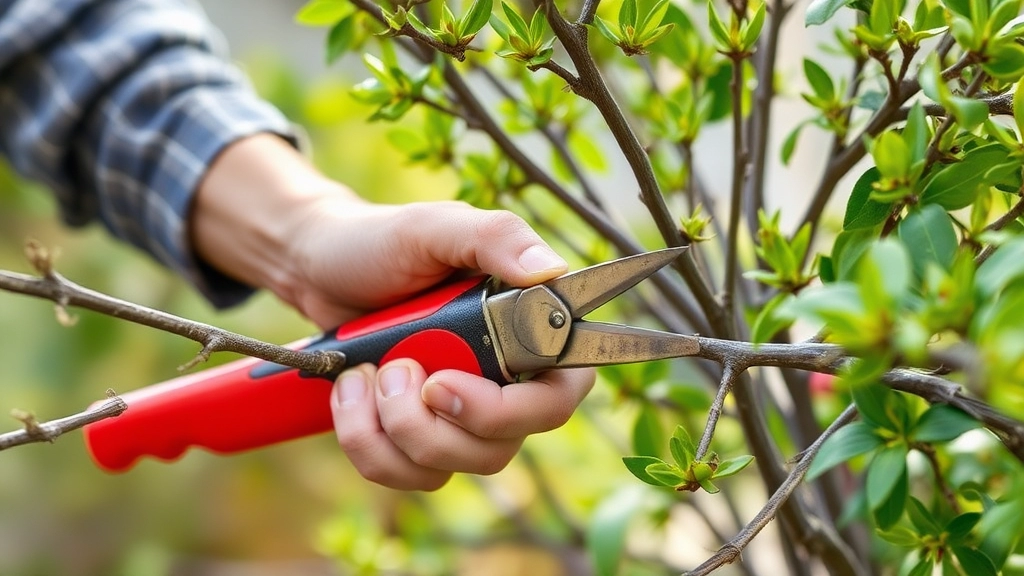
Are you wondering how to keep your Kalanchoe Gastonis-Bonnieri thriving?
Pruning and maintenance are key to ensuring your plant stays healthy and looks great.
Why Prune?
Pruning isn’t just about aesthetics; it helps in:
- Encouraging Growth: Snipping off dead or yellowing leaves encourages new growth.
- Shaping the Plant: It helps maintain a tidy shape and prevents it from becoming leggy.
- Preventing Disease: Removing unhealthy parts reduces the risk of pests and diseases.
How to Prune Your Kalanchoe
Here’s a simple guide to get you started:
- Timing: Prune at the start of the growing season, which is usually spring.
- Tools: Use clean, sharp scissors or pruning shears to avoid damaging the plant.
- Technique:
- Cut just above a leaf node to encourage bushier growth.
- Remove any wilted flowers to promote blooming.
- Trim back any leggy stems to maintain a compact shape.
Maintenance Tips
Keeping your Kalanchoe in tip-top shape doesn’t stop at pruning. Here are some easy maintenance tips:
- Watering: Let the soil dry out between waterings. Overwatering is a common mistake!
- Fertilization: Use a balanced fertilizer every few months during the growing season to give it a boost.
- Cleaning: Dust the leaves occasionally to help the plant breathe and absorb sunlight.
When deciding whether to keep your Kalanchoe Gastonis-Bonnieri indoors or outdoors, you may wonder which environment will best support its growth and health. Both settings have unique advantages and challenges that can influence the plant’s overall well-being.
### Indoor Care
Keeping your Kalanchoe Gastonis-Bonnieri indoors offers several benefits:
– **Controlled Environment**: Indoor conditions allow for better control over temperature and humidity.
– **Protection from Pests**: Indoor plants are generally less exposed to pests and diseases.
– **Aesthetic Appeal**: The vibrant foliage can add a touch of greenery to your living space.
However, indoor care requires attention to specific needs:
– **Light**: Position your plant near a bright window, preferably with indirect sunlight. Direct sunlight can scorch the leaves.
– **Watering**: Indoor plants typically need less frequent watering. Ensure the soil dries out between waterings to prevent root rot.
– **Humidity**: Indoor air can be dry, especially in winter. Consider misting your plant occasionally or using a humidity tray.
### Outdoor Care
On the other hand, outdoor care can also be rewarding:
– **Natural Light**: Outdoor settings provide abundant natural light, promoting healthy growth.
– **Space to Grow**: Your Kalanchoe can spread out, allowing for optimal air circulation.
Nevertheless, outdoor care comes with its own set of challenges:
– **Weather Sensitivity**: Protect your plant from extreme weather conditions, such as frost or intense heat.
– **Pest Awareness**: Be vigilant about pests that can affect outdoor plants, such as aphids or mealybugs.
– **Soil Quality**: Ensure the outdoor soil is well-draining to prevent waterlogging.
For more detailed tips on caring for your Kalanchoe, you might find our [comprehensive Kalanchoe plant care guide](https://planthq.org/comprehensive-kalanchoe-plant-care-guide/) helpful. Additionally, if you’re interested in expanding your collection, consider exploring our [top indoor Kalanchoe varieties for vibrant home blooms](https://planthq.org/top-indoor-kalanchoe-varieties-for-vibrant-home-blooms/).
Seasonal Blooming and Flower Care
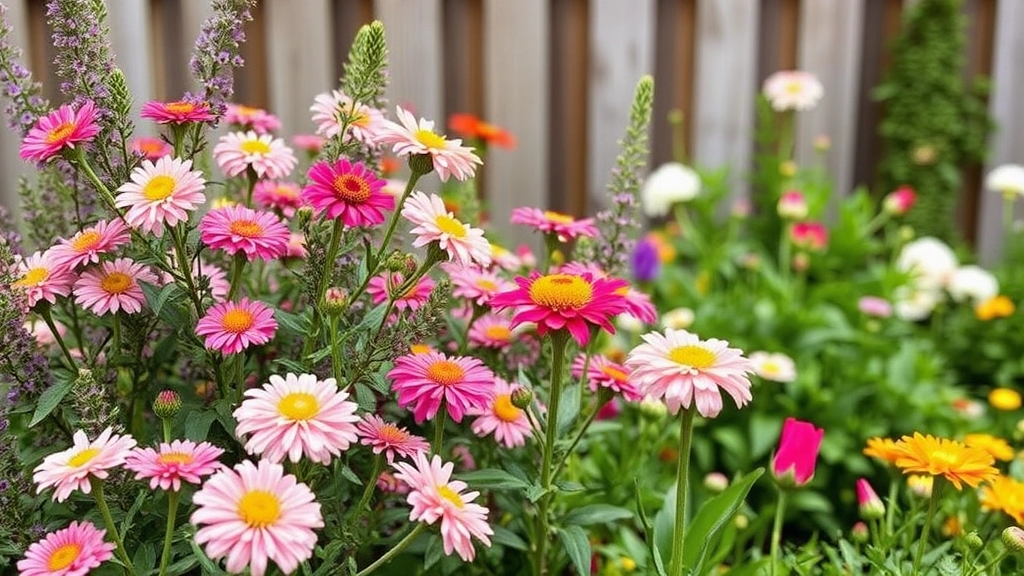
So, you’ve got your Kalanchoe Gastonis-Bonnieri thriving, and now you’re wondering about those beautiful blooms. When does it flower and how can you keep those vibrant colours coming? Let’s dive into seasonal blooming and flower care!
Blooming Season
Kalanchoe Gastonis-Bonnieri typically bursts into bloom in the late winter to early spring.
- Timing: Expect flowers around late February to April.
- Flowers: Look out for those stunning clusters of tubular blooms in shades of orange, red, or yellow.
Flower Care Tips
Caring for your Kalanchoe during its blooming season can make all the difference. Here’s how to keep those flowers looking fresh:
- Light: Ensure it gets plenty of bright, indirect sunlight. Too much direct sun can scorch those delicate petals.
- Watering: Keep the soil slightly moist but not soggy. Water when the top inch feels dry.
- Fertilization: Use a balanced, water-soluble fertiliser every couple of weeks during blooming to give it a boost.
Post-Bloom Care
Once the flowers start to fade, don’t panic! Here’s what you can do:
- Deadheading: Snip off spent flowers to encourage new growth.
- Pruning: After blooming, give your plant a little trim to maintain its shape and health.
- Rest Period: Allow your Kalanchoe a rest period with less watering and no fertiliser to recharge.
Handling Temperature Sensitivity
When caring for Kalanchoe Gastonis-Bonnieri, temperature sensitivity is a vital aspect to consider.
Many plant enthusiasts worry about how temperature fluctuations can impact their beloved succulents.
Frequently Asked Questions about Kalanchoe Gastonis-Bonnieri (Donkey Ears)
How often should I water my Kalanchoe Gastonis-Bonnieri?
Water your Kalanchoe only when the top inch of soil feels dry. This generally means every 2-3 weeks, depending on your environment. Ensure excess water drains out to avoid root rot.
What type of fertilizer is best for Kalanchoe Gastonis-Bonnieri?
A balanced, water-soluble fertilizer with a 20-20-20 mix is ideal. Feed your plant every 4-6 weeks during the growing season (spring and summer), and always dilute the fertilizer to half the recommended strength.
What are the signs of overwatering and underwatering?
Overwatering: Yellowing leaves or mushy stems indicate that you need to cut back on watering. Underwatering: If the leaves start to shrivel, it’s time to give your plant a drink.
What pests should I watch out for?
Common pests include aphids, mealybugs, spider mites, and scale insects. Regular inspections can help you catch these pests early.
How can I prevent diseases in my Kalanchoe Gastonis-Bonnieri?
To prevent diseases like root rot, powdery mildew, and leaf spot, ensure proper watering, good air circulation, and regular inspections. Neem oil can also help manage pest infestations.
When and how should I prune my Kalanchoe Gastonis-Bonnieri?
Prune at the start of the growing season (usually spring). Use clean, sharp scissors or pruning shears, and cut just above a leaf node to encourage bushier growth. Remove wilted flowers and trim back leggy stems to maintain a compact shape.
When does Kalanchoe Gastonis-Bonnieri bloom?
This plant typically blooms in late winter to early spring, around late February to April. Look for clusters of tubular blooms in shades of orange, red, or yellow.
How should I care for my Kalanchoe during its blooming season?
Ensure it gets plenty of bright, indirect sunlight and keep the soil slightly moist but not soggy. Use a balanced, water-soluble fertilizer every couple of weeks during blooming to give it a boost.
What should I do after the flowers fade?
After the flowers fade, snip off spent blooms (deadheading) to encourage new growth. Prune the plant to maintain its shape and health, and allow it a rest period with less watering and no fertilizer to recharge.
References
-
Kalanchoe Plant Care: How To Grow A Kalanchoe
-
Growing Kalanchoe Succulents Indoors
-
Kalanchoe: How to Grow and Care for Kalanchoe Plants
